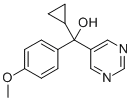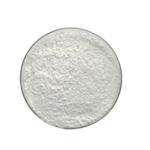Ancymidol is a white to buff colored crystalline
or granular solid. Slightly aromatic odor.
Ancymidol has been used as the cytochrome P450 inhibitor to study its effects on Cyanidioschyzon merolae?strain.
ChEBI: A tertiary alcohol that is methanol in which the hydrogens attached to the carbon are replaced by cyclopropyl, p-methoxyphenyl and pyrimidin-5-yl groups. By inhibiting gibberellin biosynthesis, ancymidol reduces plant growth, resulting in redu
ed internode elongation and thus more compact plants. It is used in the commercial production of a wide variety of container-grown bedding and foliage plants, including chrysanthemums, Easter lilies and poinsettias.
Ancymidol, a-cyclopropyl-a-(4-methoxyphenyl)-5-pyrimidinemethanol (EL-53 1), a plant growth retardant is a synthetic pyrimidine analogue. It is also a weak fungitoxic.
Ancymidol is a pyrimidine-class plant cell endocrine disruptor plant growth regulator that interferes with gibberellin and cellulose biosynthesis.
Ancymidol is a plant growth regulator
registered for treating container-grown herbaceous plants,
ornamental woody shrubs, and bedding plants grown in
greenhouses and other plant bedding areas for primarily
commercial production. Growth regulator used on plants
such as chrysanthemums, certain lilies, and poinsettias
effects produced by ancymidol are the result of inhibition
of gibberellin biosynthesis. It produces a more compact
growth form by suppressing elongation.
Dust may form explosive mixture with
air. Ancymidol may react vigorously with oxidizing agents.
Mixtures with concentrated hydrogen peroxide or strong
mineral acids (e.g., nitric, sulfuric, perchloric) may cause
explosions. Mixtures with hypochlorous acid, lead perchlorate,
chlorine, bleaches, including sodium hypochlorite;
mixed water/carbon tetrachloride solution; trichloroisocyanuric
acid form methyl hypochlorite, which can be explosive,
especially when exposed to sunlight or heat. May
react with metallic aluminum at high temperature. Flow or
agitation of substance may generate electrostatic charges
due to low conductivity; ground all equipment containing
this material. May attacks some plastics, rubber, and
coatings.
Dispose of contents and container
to an approved waste disposal plant. All federal, state,
and local environmental regulations must be observed.
References


